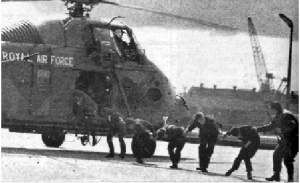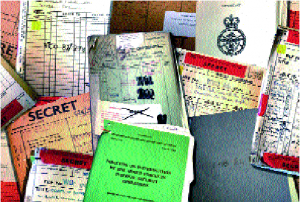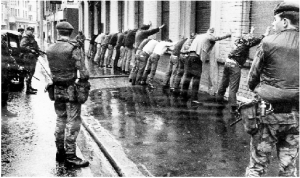The Torture Files
Published in Issue 5 (September/October), Reviews, Volume 221972 remains a key year of the ‘Troubles’: the year that witnessed the highest death toll, the most notorious mass killing—‘Bloody Sunday’—and what has by now become the most infamous single killing, the much-publicised ‘disappearing’ of Jean McConville. Bloody Sunday was the culmination of an increasingly aggressive British approach to the crisis in Northern Ireland that had begun the previous year with the introduction of internment in August 1971; 21 people had been shot dead in the course of ‘Operation Motorman’, including seventeen who were shot by British troops in Ballymurphy over a number of days. Rita O’Reilly’s stark piece of reportage dealt with another unedifying aspect of the British military’s conduct in the North: the use of what might well be described as torture.
The fact that one might quibble over the use of the term arises from a notorious case in the 1970s that saw the British government hauled before the European Commission on Human Rights in Strasbourg over whether or not fourteen men held after the introduction of internment in 1971 had been tortured—the so-called ‘hooded men’ had been subjected to what was euphemistically described as ‘interrogation in depth’. In 1976 the commission decreed that they had been—a verdict overturned two years later by the European Court of Human Rights, which ruled that while they had not been tortured they had been subjected to ‘inhuman and degrading treatment’.

Internees disembarking from an RAF helicopter. Some internees were repeatedly thrown blindfolded from such helicopters hovering a few feet above the ground. (An Phoblacht)
Thanks to the assiduous mining of documents from the UK’s National Archives by the Pat Finucane Centre and the RTÉ Investigations Unit, O’Reilly’s documentary cast light on a grim episode. ‘Interrogation in depth’, as practised by specially trained RUC officers in what appears to have been a facility designed for the purpose, had seemingly been contemplated from as early as March 1971. The ‘five techniques’ of which it consisted seem familiar from more recent controversies in Iraq: hooding, white noise (‘deafening . . . like an airplane engine’, according to one detainee), the use of stress positions, the withholding of food and water, and sleep deprivation. When combined with assault and death threats, the use of the term ‘techniques’ is revealed to be, at the very least, sanitising. Amongst those subjected to this systematic treatment was Northern Ireland Civil Rights Association (NICRA) veteran P.J. McClean, who was blindfolded and repeatedly thrown out of a helicopter hovering a few feet above the ground. Pat Shivers was forced to remain in stress positions for extended periods while wearing a hood and overalls; he generally lasted an hour before collapsing, and endured perhaps 50 hours of such treatment. Interspersed with the testimony of the survivors were horrific contemporary images of the aftermath of beatings that they endured. Unsurprisingly, there were attempts on the part of the authorities to blacken the names of the victims as murderers, or, in a strikingly Orwellian turn of phrase, as being ‘indirectly responsible for murder’.
The original case was brought to Strasbourg by Jack Lynch’s Fianna Fáil government. The British authorities were naturally relieved at the 1978 judgement that overturned the original verdict, displaying a remarkable willingness to embrace the opinion of a European institution. But documents dug out of no less an institution than the UK National Archives in Kew told a very different story. One of the ‘hooded men’, Seán McKenna, had been in the IRA. His daughter Mary claimed that ten days after his detention, during which he was subjected to the ‘techniques’, he was a broken man and never recovered from the treatment he received. He had been hooded, handcuffed to a soldier, forced to run into concrete posts blindfolded, and harassed by Alsatian dogs. McKenna had been declared fit for interrogation, despite having a heart condition noted by British army doctors. The private testimony of Prof. Denis Leigh—one of the British witnesses before the European court, who had examined McKenna in Dublin in 1975—noted that McKenna was suffering from angina and ‘a number of psychiatric symptoms, mainly of an anxious and fearful nature’: Leigh ascribed these, and the worsening of McKenna’s angina, to the ‘so-called “deep interrogation” procedures’. McKenna died within days of this examination; the report on the impact that the interrogations had on McKenna was never brought to the attention of the European authorities. The official British stance was that the after-effects of ‘interrogation in depth’ were minor and short-lived and thus were not of a piece with torture, as broadly understood. But family members testified to the physical and mental after-effects on their loved ones.

Thanks to the assiduous mining of documents from the UK’s National Archives by the Pat Finucane Centre and the RTÉ Investigations Unit, the documentary cast light on a grim episode. (RTÉ)
In December 1973 Liam Cosgrave’s government stated that they were not making accusations against individual British ministers as such. Yet the private views of the British, as revealed in the documents found in Kew, suggests that such faith was misplaced. The cases brought by the ‘hooded men’ were all settled out of court. By October 1974 the legal implications were obvious: a court case could open the door to charges of conspiracy against a range of individuals, perhaps even former ministers—hence the desire to settle. But in 1977 Home Secretary Merlyn Rees was privately of the opinion that the ‘five techniques’ had been sanctioned at ministerial level. O’Reilly’s conclusion was stark: that a British Conservative government authorised the use of torture, and British Labour governments covered it up. Her methodical investigation made, as she put it in the Irish Times (12 June 2014), ‘a compelling case that torture was sanctioned by the government of a democratic European state against citizens’.
This has not been the first allegation of British misconduct in Northern Ireland reiterated in recent times (see James Hughes’s article on General Sir Frank Kitson in HI 22.1, Jan./Feb. 2014). But this case has had an enduring relevance. While Prime Minister Ted Heath had explicitly banned the five techniques in March 1972, they have resurfaced in allegations of the mistreatment of prisoners by British forces in Iraq. Tellingly, the 1978 judgement was used in 2003 by the US attorney general to justify ‘a wide array of acts that do not amount to torture, thus appearing to permit, under international law, an aggressive interpretation’. The abuse of human rights was not, and is not, the exclusive province of paramilitaries. This stark and sobering report was a reminder of why a full and frank accounting of the human cost of the ‘Troubles’ is a laudable objective, while also serving to remind viewers of why such an accounting might remain elusive.
John Gibney is on-line editor of History Ireland and of the Decade of Centenaries website, www.decadeofcentenaries.com.

















